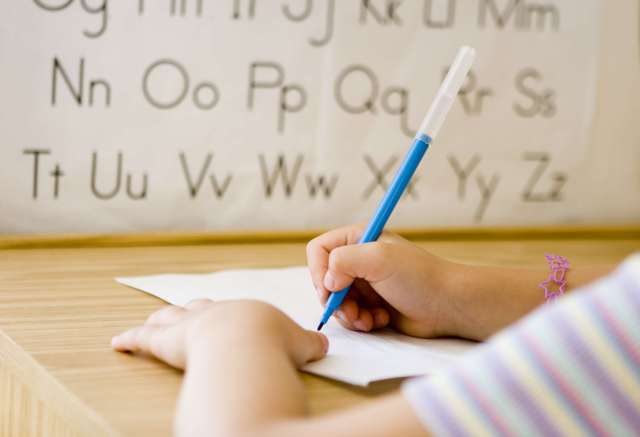When learning how to form the letters of the alphabet, children respond differently whether they are kinesthetic, auditory, tactile, and visual learners. In addition to supporting a child’s preferred learning style, using various methods can also increase the “fun factor” when practicing how to write!
Kinesthetic Learners:
Kinesthetic activities provide children with opportunities to learn through movement. Children who prefer this learning style may find it more challenging to sit still when engaged in a learning activity. Their capacity for learning increases when both their brain and their body are engaged.
You may think a kinesthetic-based activity is a challenge for an activity that is traditionally done with paper and pencil, but movement can definitely be incorporated into writing activities. For example, have children hold scarves and use big arm movements to write the letters in the air. Or, have the children move around the room then freeze when you call out a letter. Their task is to form the letter with their bodies. They might create the letter “L” by having two friends lie on the floor in the correct formation. Or, they might decide they can make the letter “t” all by themselves by sticking their arms straight out on each side.
Auditory Learners:
Auditory activities appeal to children who learn best through actively listening. They may also find it helpful to talk about the material they are learning. Providing auditory learners with opportunities to both hear and recite information is ideal.
To incorporate the auditory learning style in writing practice, children can be taught rhymes or sayings that help them remember the pathways to use when forming letters. For example, children can use the rhyme, “Pull straight down for capital E. Then add some shelves. 1, 2, 3!” Hearing this rhyme, then remembering and reciting it themselves, can help children when they forget how to print a letter.
Tactile Learners:
Children who prefer tactile activities learn best by touching and manipulating objects. They generally prefer “doing” over simply hearing or seeing instructions. They are often referred to as “hands-on learners,” and prefer activities like building, using art materials, and using manipulatives.
There are many ways to incorporate tactile opportunities into learning how to write letters. Children can use their index finger to practise printing letters in trays filled with salt, sand, or shaving cream. Children can use paintbrushes and water to “paint” the letters on chalkboards or other surfaces like a brick wall. Tactile learners may enjoy using playdough to create the letters. Working with a partner, they can also take turns printing letters on each other’s back. To support tactile learners’ recall of letter formations, have them make the letters using art materials like stamps, pipe cleaners, or stickers.
Visual Learners:
Visual learners benefit from seeing the material they are learning. They may prefer to read and write versus listening and speaking. They can typically recall information better if it has been presented to them visually.
When learning how to write letters, children who are visual learners can benefit from seeing the letters and writing them. Provide these learners with a visual of what the letter they are learning looks like. Provide them with opportunities to trace the letter before moving on to independent practice where they write the letter themselves. Visual learners who are focusing on printing can benefit from the handwriting worksheets.
These tracing letters worksheets provide children with the steps to forming each letter, using the proper pathways. Tracing the letters allows children to rehearse the pathways before moving on to independently writing.
To support visual learners who are focusing on cursive writing, worksheets that follow the same pattern as the printing worksheets can be used: Provide a model of the letter, allow for opportunities to trace the letter, then move on to independent practice.
These cursive letters worksheets also provide students with practice linking cursive letters together to form words.
The worksheets noted above have been carefully crafted with appropriate lines to promote the correct sizing of letters. Young children who are experimenting with writing may print very large letters. As they become more experienced with writing, children need guidance around which letters are tall and which letters are short. They also need guidance to correctly write “tail” letters, which have parts that hang below the line, like “p” and “y.”
Providing children with multiple ways to practice writing letters can help them to be successful and also maintain their engagement in the learning process. Worksheets will help them achieve the end goal of being able to correctly form written letters on paper.











